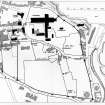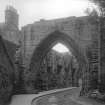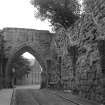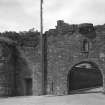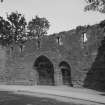Following the launch of trove.scot in February 2025 we are now planning the retiral of some of our webservices. Canmore will be switched off on 24th June 2025. Information about the closure can be found on the HES website: Retiral of HES web services | Historic Environment Scotland
Field Visit
Date 24 July 1926
Event ID 1099168
Category Recording
Type Field Visit
Permalink http://canmore.org.uk/event/1099168
Abbey Wall and the Pends.
That the property of the Priory was enclosed from at least the 14th century is certain, the gatehouse known as "The Pends" being of that time. The present wall of the precinct, however, with its towers dates only from the early 16th century. Hector Boece, a contemporary writer, states that, after making sundry improvements and repairs in the cathedral and priory buildings, Prior John Hepburn surrounded the whole with a wall having a great number of towers (1). This Hepburn died in 1522, but there is evidence also of at least a contribution to the work by Prior Patrick Hepburn, his nephew and successor. On the first wall-tower north of the Mill Port or "Sea Yett" (SC 1108089), which is now enclosed by the buildings of the gasworks, is the inscription: [P]RECESSORI[S] OP: POR: HICPAT: HEPBVRN EXCOLIT EGREGIVS ORBE SALVT. Professor Rose suggests that an elegiac couplet is intended. This seems very probable and the inscription may then be expanded thus: PRECESSORIS OPVS PORRO HIC PATRICIVSHEPBVRNEXCOLIT EGREGIVS ORBE SALVTIFERO.As a mural tower is in question, and as a common Scots term for such is "round,"(cf. Art. No. 469), the word ORB IS may be taken to have this meaning, so that with SALVTlFER it would be the equivalent of what is also a common description, "a tower of 'fens (defence)". The translation would therefore run: "Here the excellent Patrick Hepburn in his turn embellishes the work of his predecessor with a tower of 'fens". The surname is interrupted by a small shield backed by a crook and bearing the Hepburn arms, below which is the motto, EXPECTO. What now remains of the wall is indicated by a continuous line on the block plan (SC 369410), the course of the missing northern stretch being shown by a broken line. It starts at the 15th century north-eastern buttress of the Cathedral and runs in a north-easterly direction for a distance of II yards up to a round tower, marked No. 1 on Fig. 397. This stretch is apparently of later origin than the remainder. The fact that it has a gate, 9 feet 8 inches wide, with a broad splay both on the jambs and on the semicircular head, suggests that, when it was erected, the precinct had been reduced in area, the Cathedral itself becoming the northern boundary. Over the gateway is a niche withthe lower part of a seated effigy, and on eitherside is a loop. Above the northern loop is an armorial panel, probably a later insertion, bearing the Hepburn arms, the motto ADVITA[M] being carved below the hood. From Tower No.1 the wall originally trended towards the north-west to enclose what is now part of the churchyard, but of this stretch nothing is left but the first nine yards.
From the other side of the tower the wall runs in a south-easterly direction for a distance of 130 yards, and in this length there are three towers, Nos. 2-4. From Tower No. 4 the wall continues almost due south for a distance of 345 yards and has in that length four towers, Nos. 5-8, the first of these bearing the inscription given above, as well as the "Sea Yett,"as it was known in pre-Reformation times, or "Mill Port," as it was called a century later, on which are the Hepburn arms below a niche and again on a panel at the wall-head. South of this gate are the blocked-up windows and doors of a range of buildings facing the quay of the inner harbour, which were probably warehouses built on the inner side of the wall, and beyond them there is an archway near Tower No.8.From Tower No.8, which was a dovecot, the wall runs westward for 383 yards. In this portion is the "Teinds Gate" [SC 1108090], flanked by Towers Nos. 9 and 10, behind the first of which lay the "Teinds Barns." The main archway of the Teinds Gate, has a smaller archway at one side for pedestrian traffic. The gatehouse above was lit by six oblong chamfered windows looking south. Beyond are the Towers Nos. 11 and 12. A thinner wall is continued westward from Tower No. 12 for a length of 80 yards and then abuts on the last tower of the series, No. 13. But from the former tower the main wall runs northwards for 170 yards, ending at" St. Leonard's House," whence it must have swung inwards, or towards the north-east, to meet the main gatehouse, now known as "The Pends." In all probability, therefore, the wall west of Tower No. 12 represents an extension at the south-western corner of the precinct. Tower No. 13, on which one jamb of a gate can be traced, may thus have been one of the gate-towers, but, from its position, it was more probably an intermediate tower. From it a wall ran northwards behind the houses on the east side of Abbey Street.
If Towers Nos. 8 and 12 be accepted as the southern limits and if the missing northern stretch was as is shown, the precinct had an area of about 30 acres. The wall, which was almost a mile in length, stands to an average height of 20 feet and is over 3 feet thick. Of the sixteen towers counted by Martine previous to 1683, only thirteen remain. Nos. 2-4 are oblong on plan, while the rest are round. All are provided with loops and are decorated with niches, those on Tower No.2, which is known as the "Haunted Tower,' having bases formed of carved stones removed from the Cathedral. On this tower are the Hepburn arms with the initials [PJ LH., for Prior John Hepburn, on the protective hood, while above the hood is a slab carved with a pot of lilies. As already stated, the Hepburn arms are repeated both on the "Sea Yett" and on Tower No.5, but they are also found on the wall between Towers Nos. 10 and 11 and in two places on the stretch between Towers Nos. 11 and 12. It would appear that access to the top part of the towers was obtained from a parapet-walk on the wall. In the case of the "Haunted Tower" (No.2) an upper room was reached from a forest air, while the vaulted apartment below was entered from the ground. The tower next to it (No.3) was found to contain a stair, which apparently served only the upper part. Tower No. 12 also has the remains of a stair.
RCAHMS 1933, visited 24 July 1926.
(1) Scotorum Historice (ed. 1527), lib. vi, fo. cix recto.











